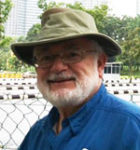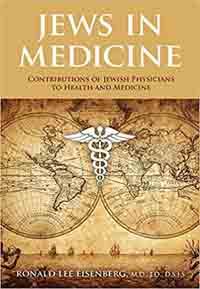Jews in Medicine, Contributions to Health and Healing through the Age by Ronald L. Eisenberg Jerusalem and New York: Urim Publications, 2019, 464 pages, $34.95
By Oliver B. Pollak

 JACKSON HOLE, Wyoming — This 464-page encyclopedic reference book starts with the Talmud and comes into the present including still living practitioners. The author identifies Jewish physicians in Islamic and Christian lands before the 1492 expulsion from Spain. About 70 percent of the book is devoted to the Modern Era marked by the Age of Specialization. The basic sciences include bacteriology, microbiology, infectious diseases, biochemistry, cell biology, DNA-RNA research, genetics, immunology, pharmacology, and physiology.
JACKSON HOLE, Wyoming — This 464-page encyclopedic reference book starts with the Talmud and comes into the present including still living practitioners. The author identifies Jewish physicians in Islamic and Christian lands before the 1492 expulsion from Spain. About 70 percent of the book is devoted to the Modern Era marked by the Age of Specialization. The basic sciences include bacteriology, microbiology, infectious diseases, biochemistry, cell biology, DNA-RNA research, genetics, immunology, pharmacology, and physiology.
The Clinical Medicine section covers cardiology, cardiac surgery, dermatology, endocrinology, gastroenterology, hematology, internal medicine, medical imaging, radiation oncology, neurology, neurosurgery, neuropsychology, obstetrics/gynecology, ophthalmology, otolaryngology, pathology, pediatrics, psychiatry, psychology, surgery, virology as well as public health, prizes, medical education, medical administration, closing with physicians and medicine in the State of Israel.
The table of contents mentions about 188 specific articles on physicians and the Index contains about 416 names of physicians. But this is a substantial understatement especially in terms of women practitioners. For instance, the Contents lists Sarah of Würzburg who practiced medicine in the early 15th century, but within her seven-line entry are mentioned Rebekah Zerlin of Frankfurt and Sarah La Migresse of Paris, neither of whom are in the Index. There were about eighteen entries for women. The bibliography includes Women and the Practice of Medical Care in Early Modern Europe (2011) by Leigh Whaley.
Familiar names include Moses ben Maimon (Maimonides), Baruch Spinoza, August Paul von Wasserman, Victor Emil Frankl, Anna Freud, Sigmund Freud, Cesare Lombroso, Abraham Flexner, Albert Bruce Sabin, Jonas Edward Salk, and Henrietta Szold. These are heroic names. Flexner, who introduced modern American medical education, was the subject of a brilliant biography by Thomas Neville Bonner, Iconoclast: Abraham Flexner and a Life in Learning (2002).
Professional achievement is rewarded with honors and money prizes. The Lasker Award, (The American Nobel Prize), named for Albert Davis Lasker, wealthy publicist and philanthropist, instituted in 1945, distributes prizes of $250,000. The Nobel prize comes with about $1.1 million.
Much is known of Maimonides, the Rambam. He is mentioned on at least nine pages besides one Index reference. There is one mention of Nachmanides of Girona, Ramban, on page 32 which is not in the Index. Ramban however appears to be an enigma. He does not receive a paragraph. Eisenberg confesses it “is impossible to include every Jewish physician who has made meaningful contributions to the development of medicine.” Dr. Eisenberg has presented so many remarkable and compelling stories; the reader wants more.
Reference books sparkle when the readers have easy access to information. While a prodigious number of names is impressive, readers would be assisted by vital topical entries.
So much information begs to be collated and organized in a number of different ways. A brief review of the Psychiatry and Psychology section reveals that seven of the thirteen practitioners came from Vienna. Jews also “flocked” to dermatology, neurology and ophthalmology.
If the Index incorporated topics or an electronic version of the book permitted name and word searches future researchers might identify prosopographical patterns. For instance, career trajectories for Jewish children arriving in America under 5 years of age. A second edition would benefit from enhanced documentation for each biographic paragraph and an enlarged and upgraded Index.
My reading suggests this valuable book would be even more prized if the Index contained topics like bad breath, bibliophiles, cancer, childhood diseases, collaborative research, conversion, discrimination in admission, licensing, hiring and promotion, emigration from Russia, 1930s flight from Germany, Concentration Camp medicine and the Holocaust, Hadassah Hospital, Israel, Lasker Prize awardees, manuscripts, medical schools by name (Salerno, Bologna, Padua, Pisa, Montpellier), military medicine, multi-generation physician families, Nobel Prize awardees, people named within paragraphs, quota system, syphilis, teachers, translations, veterinary medicine, Vienna, Warsaw, women physicians, and Zionism.
Perhaps allergists (Denver Jewish Hospital), dentistry, Nachmanides, nurses and Oliver Sacks could be included in a second edition. The author and publisher of encyclopedic reference books should provide finding aids so readers can efficiently and intelligently use the book. A second edition would give Eisenberg the opportunity to include two of the three people to whom he dedicates the book, his physician father an “unsung Jewish medical hero,” and his radiology mentor who died in 2018 at the age of 97, as well as my grandfather who practiced medicine in Theresienstadt concentration camp.
The author Ronald L. Eisenberg is a Professor of Radiology at Harvard Medical School and a radiologist at the Beth Israel Deaconess Medical Center in Boston. He earned his medical degree at the University of Pennsylvania in Philadelphia, law degree at William Howard Taft University in California, and DSJS (Doctor of Science in Jewish Studies) from Spertus Institute in Chicago. He has published about twenty books on various aspects of Jewish life and radiology.
*
Pollak, a professor emeritus of history at the University of Nebraska Omaha, and a lawyer, is a correspondent now based in Richmond, California. He may be contacted via oliver.pollak@sdjewishworld.com
Pingback: Book Review: “Jews in Medicine” | Jewish Book Review